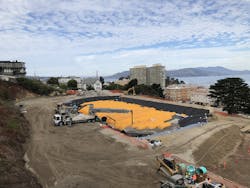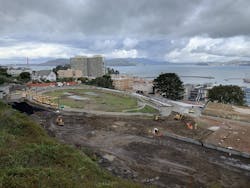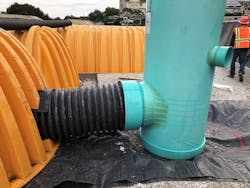From Flume-Fed to Sustainable Water Supply
About the author:
Steve Cooper is a writer for SCA Communications. Cooper can be reached at [email protected].
The Francisco Street Reservoir in San Francisco dates to the 1850s will do double duty as a source of non-potable water in addition to being a public park. When completed, the 4.5-acre Francisco Park will feature a picnic area, a dog run, a community garden, a reservoir interpretive area, a children’s playground and restrooms. Underneath the large central open area is a stormwater capture and reuse system that will perpetually provide water for the park’s irrigation and toilet flushing needs.
Virtually abandoned for nearly 80 years, the community formed the Francisco Park Conservancy to explore options for the land, which is a landmark on Russian Hill along with Lombard Street, Ghirardelli Square and the San Francisco Art Institute. The project is a public-private partnership between the San Francisco Recreation and Park Department (RPD) and the Francisco Park Conservancy (FPC).
Flume & Pump System History
When built in 1859 it was the first large reservoir in San Francisco and was needed to supply fresh water to the rapidly increasing population brought on by the gold rush and the Comstock lode. At first, water was delivered downhill to the reservoir from Mountain Lake using a wooden flume and pump systems at the base of the hill.
“The plan to convert the reservoir spanned many decades,“ said Cody Anderson, P.E., and principal of Sherwood Design Engineers, the firm responsible for the stormwater system. “It was decommissioned in the 1950s and was on the docket to be developed. It was the Francisco Park Conservancy that really gave the project legs. They were interested in the stormwater system as a way to harvest rainwater. It would also provide an additional educational component and the footprint of the old system was there. But they didn’t have to do that. They just could have filled in the reservoir with soil. But our initial earthwork estimate showed 55,000 cubic yards of import would be needed. This would be unfavorable due to the area. That’s a lot of truck trips into the neighborhood when you’re looking at 10 to 12 cubic yards per truck. This convoy would create a lot of congestion and not be in the best interests of the environment.”
Collected stormwater is treated to produce non-potable water that meets San Francisco Department of Public Health standards. This water is reused to meet the site’s irrigation and the flushing needs of six toilets. The stormwater is first stored in what is basically a 500,000-gallon cistern at the top of the hill before being transferred to the service building where it flows through a series of filtration and disinfection processes. This ensures that the water meets public health regulations while saving 1.5 million gallons of potable water every year by not having to use city water. There is also a smaller unit at the bottom of the hill.
Cistern Construction for Stormwater Detention
To construct the main cistern or stormwater detention unit, Anderson decided to use a system of arched chambers because they would provide the largest storage volume per square foot.
“There are competing products on the market and we needed to store as much water as possible in the given 18,000 square foot area,” he said.
Anderson specified two types of StormTech Chambers that would be installed using 114-feet by 147-feet of the existing reservoir and then covered with soil. The system has 72 StormTech MC-3500 chambers and 300 StomTech MC-4500 chambers for a total storage volume capacity of 535,919 gallons (71,642 cubic feet) of water in a 18,098 square foot area. A product of Advanced Drainage Systems, the chambers are designed in accordance with AASHTO, ASTM, CSA and European design standards, qualifying them for use in commercial and municipal projects. They are made from an engineered grade of impact-modified polypropylene copolymer, and have a minimum 75-year service life.
Along the sides and on top of the chambers, ADS 0601TG non-woven geotextile was used as a soil separation layer. Underneath the chambers, woven geotextile was used to add scour protection. The chambers rest on a bed of crushed rock.
“On a lot of projects, we use these systems to meet different construction stormwater requirements,” Anderson said. “Here, we’re filling in only about two-thirds of the reservoir and then it slopes back down to its historic brick surface where they have the education component and the playground. The reservoir is on slope that is just under 20%. It’s a very challenging site from a variety of perspectives.”
Because of the steep grade and the historic reservoir’s location midway up, Anderson said half the runoff is collected through gravity flow while the rest is collected at the bottom of the site. It is then filtered through a screen before it enters the chambers for storage and future use.
“The big question was accessibility to the first filtration chamber,” he added. “We had to make sure the city could get their rigs and a vacuum truck there for maintenance.”
Pipes & Pumps
There are four, 36-inch diameter ADS Nyloplast units with ladders for access into the system. Three StormTech Isolator Rows are included in the system as well. These are designed to capture the first flush and trap sediment and other total suspended solids (TSS) coming from the stormwater drainage. The isolator rows can be cleaned out by a Jet-Vac process using access from any one of the inspection/clean out ports.
Additionally, a run of 6-inch ADS N-12 high-density polyethylene (HDPE) perforated pipe serves as an underdrain providing an outlet, or available exit, for any stormwater left standing in the base rock layer below the StormTech chambers.
Two rainwater collection points were required at the Francisco Park because it is located on the side of a hill. The flat, main lawn area with the old reservoir has the new StormTech system underneath, and down a steep slope there is a smaller, lower flat area close to Bay Street. To capture and temporarily hold water from this area, Anderson designed a system that uses two 40-foot runs of 60-inch diameter ADS HP Storm pipe with watertight joints. The water is then pumped up to the upper StormTech storage system for filtration and use.
“We do a lot of projects where we look at holistic water management,” Anderson said. “We’re a San Francisco-based firm and actually the largest civil engineering firm that is headquartered in the city. We work on projects around the globe with an emphasis on sustainable development and we’re known for having the vision and the technical capacity. The Francisco Park is one of those projects of a lifetime. It’s reclaiming an area in the city of San Francisco that is now a beautiful park for the people. We’re really just proud to be part of that project.”
Anderson gave credit to the conservancy and emphasized how this project provides a prime example of how value engineering can enhance a public park while providing stormwater management benefits.
About the Author
Steve Cooper
Steve Cooper is a writer for SCA Communications. Cooper can be reached at [email protected].



